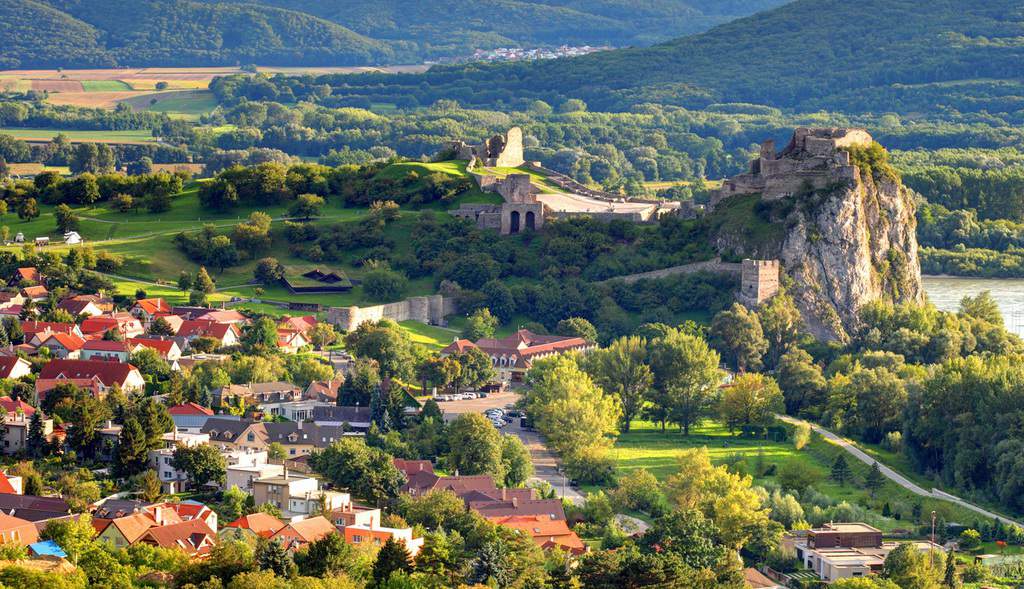Recommended Central & Eastern European Cities to Explore
It’s time to start planning that next adventure again! In fact, research shows one of the largest boosts in happiness comes from the simple act of planning a vacation and when compounded with having to wait and work hard for something, it also creates an increased sense of pleasure and value.
Now, more than ever, is the time for planning; there is after all, no time like the present. But, let’s think outside the box. With approximately 7.5 million hectares of grapes planted across nearly every continent, there is no shortage of new places to explore and adventures to be had – particularly for wine lovers. Take the countries of Central and Eastern Europe for example. Many countries here have a long, even ancient, history of grape growing and wine production.
In brief, records indicate grape growing and wine production dates back centuries in the Central and Eastern European regions. However, and unfortunately during the Communist era, much of the production in the region was focused on quantity over quality, devastating the reputation of wine from the area. Eventually, with the fall of the Iron Curtain in the late 1980s and early 1990s, the region slowly began to return to its long-held winemaking traditions. Aided further by grants and capital infusion from the European Union, grape growers and winemakers in Central and Eastern Europe were able to update facilities and combine both the traditions of their forebearers with quality controls and modernization. And today, the region is fast growing in wine production with Romania in sixth worldwide, followed by Hungary.
RELATED: 3 Week Central European Itinerary For Active Travelers
While wines of these regions are making their way to more wine lists and store shelves, it can still be difficult to know where to start when planning a wine-focused adventure. As starting is often half the battle, here are a few suggestions to kick off your wine travel experiences in Central and Eastern Europe.
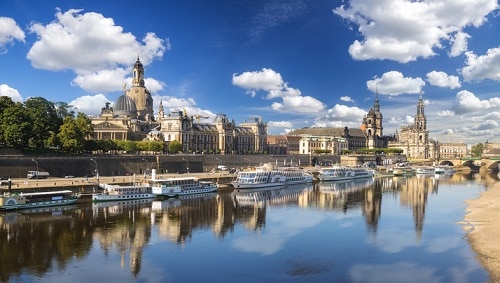
Germany
The Mosel, the Rheingau and Pfalz and the many outstanding wine regions of western Germany are mostly well-known, but have you ever considered exploring Sachsen (Saxony)? Sachsen is the easternmost and one of the smallest wine-growing regions in Germany with a winegrowing history dating back 800 years. Wines produced here are primarily white including Müller-Thurgau, Riesling, Pinot Blanc and Pinot Gris with red wines coming from Pinot Noir. The Sachsen wine region is most easily accessed from Dresden, Germany.
Dresden, Germany
Dresden, a magnificent display of baroque architecture, was a cultural center for the Saxon region. It enjoyed a golden age under the rule of August the Strong and his son Friedrich August II from 1694-1763, at which time many of the city’s famous structures were built including the Zwinger Palace, Hofkirche, Frauenkirche and the Taschenberg-palais.
Dresden also played a significant (and controversial) role in World War II as it was the site of an extensive aerial bombing attack on Germany by both British and U.S. forces, after which the Germans surrendered three months later. The attack decimated the city center. After the war, some of the structures including the Zwinger Palace and the Semperoper (opera house) were rebuilt to their original grandeur where possible reusing original materials; while other areas including Neumarkt and the Frauenkirche were left in rubble as a memorial to the horrors of war. Since German reunification, many more areas (including those left previously untouched) have undergone significant restoration and the city is once again vibrant, full of culture and architecturally stunning.
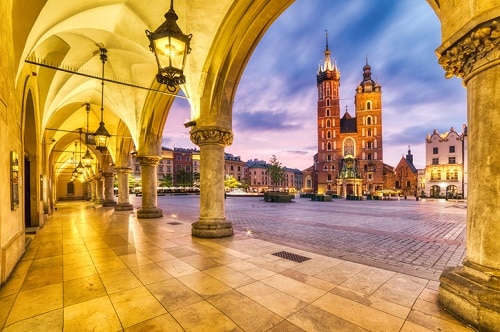
Poland
Yes, Poland for wine! Viticulture in Poland dates to the 900s when winemaking was introduced around the same time as Christianity. Wine production, however, declined over time with increasing exports, and eventually was decimated in World War II and during the Communism era. However, in the 1990s, Vitis vinifera plantings began to arise again in Poland, most notably with Agnieszka Wyrobek Rousseau, who planted 100% vinifera and the first bio-dynamic vineyard in Poland near Krakow. Since then, Polish winemaking has been on the rise and today there are more than 200 registered wineries.
A visit to Poland for wine tasting surely must begin with Ms. Rousseau and the first and only bio-dynamic winery near Krakow in the city of Wieliczka. Wieliczka, a 20-minute drive from Krakow is also home to one of the country’s famous salt mines which reach 327 meters below ground!
Krakow, Poland
As for Krakow, a city mostly spared during WWII, it retains much of its original architecture and is home to one of the largest and most lively market squares in Europe. Market Square (pictured above) (‘Rynek Główny’), dating back to the 13th century, is an expansive open space surrounded by restaurants, beer gardens and shops, and anchored by St. Mary’s church from which a trumpet call marks the hour.
Running through the center of the square is Cloth Hall. Cloth Hall saw its hey-day in the 15th century when Kraków was the capital of Poland, and the Hall was the center for international trade. Merchants met here to trade everything from spices to textiles. Today it retains its architectural charm and entrepreneurial spirit; although now it hosts shops from which tourists can find a plethora of Polish souvenirs.
And to see where the first vines were planted in Poland, wander the grounds of Wawel Castle. Built in the 14th century for Casimir III the Great, Wawel is a massive structure, which has seen numerous expansions throughout the centuries. It sits high on Wawel Hill, once home to the country’s first vineyards and overlooking the Vistula River.
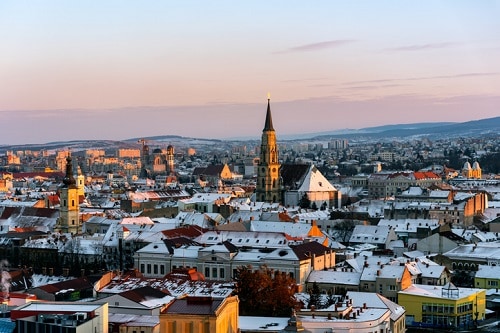
Romania
As previously noted, Romania is sixth in the world for wine production and it has one of the oldest winemaking traditions in the world. Eight wine regions can be found spanning the country with the DOCs found at the sub-regional level. Wine is a significant part of Romanian culture and the typical beverage of choice served with meals. One of the oldest wine-producing areas in Romania is the historical region of Transylvania, situated in the middle of the country and bound to the east and south by the Carpathian Mountains. Its wine production dates back more than 6,000 years! To best access the wineries in the region, the mountain town of Cluj-Napoca is the place to begin.
Cluj-Napoca, Romania
Cluj-Napoca is the ‘capital’ of Transylvania and well-known for some of Europe’s most-loved electronic music festivals. The city has three main squares in the historic city center: the main and largest square, Unirii Square, Mihai Viteazul and Avram Iancu. Each of the squares is lined by historic buildings and brimming with cozy bars and Bohemian-style restaurants. Cluj-Napoca also has numerous green spaces like Central Park, along the city’s riverbank and a Botanical Garden featuring more than 250 varieties of roses. Romania’s second-largest Gothic church and dozens of baroque buildings and medieval towers are found throughout the town. It is a city overflowing with students and artists, and a fascinating place to explore before venturing into Transylvania’s wine country.
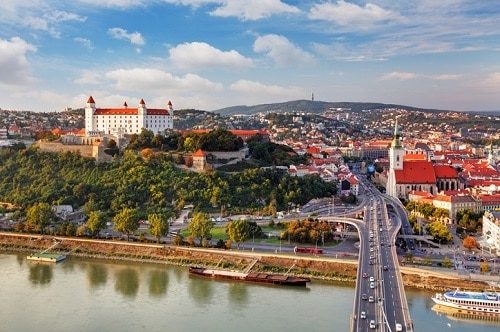
Slovakia
Of the six Slovakian wine regions found around the Eastern European country, the Malokarpatská wine region sits just north of Bratislava. Here, vineyards are planted on the slopes and plains of the Lesser Carpathian mountain range and in locality Záhorie. The first written mention of the Svätý Jur sub-region dates back to 1209 AD with vineyards accounting for around 700 hectares. However, during Communism, the local state-run collective reduced the number of vines and only worked approximately 450 hectares. Today, the wine culture is once again developing, and quality is the center of focus.
Bratislava, Slovakia
Bratislava effuses with an old medieval and gothic European vibe in the square and a dynamically changing metro area. This is a young democratic region still very much in the midst of transition, but that’s part of its absolute charm and fascination. Old Town and Hlavné Námestie (Main Square) are filled with quaint streets, restaurants, bars, shops and even a wine museum. The city sits on the Danube River and to the north are the Malé Karpaty (Small Carpathians) and their lowlands, also draped with vineyards. It is another city of contrast and transition, blending the old and the new, and it is certainly filled with intrigue. Bratislava will likely gain in popularity for tourists visiting Vienna and Budapest, but for now it is almost as though one is discovering a lesser-known treasure.
Remember, there is no time like the present to create happiness by planning your next adventure. The question isn’t when, but where will you begin?
You are reading “Most Beautiful Central & Eastern European Cities to Visit” Back To Top
which European cities to visit, Europe travel ideas: best destinations in Germany to visit
If you enjoyed this guide, consider joining the Facebook Group to interact with other Winetravelers and for travel inspiration around the world, and be sure to follow along with us on Instagram.
